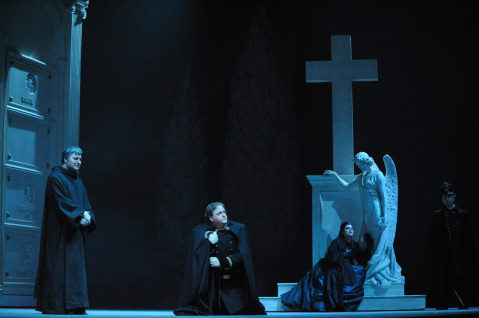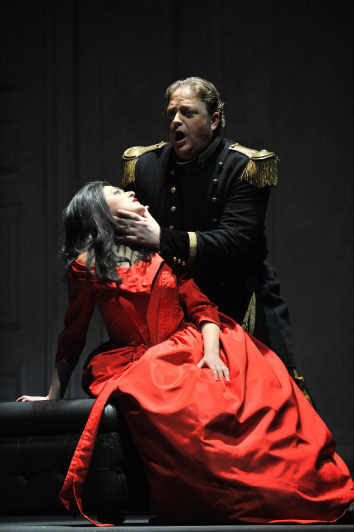Other Links
Editorial Board
-
Editor - Bill Kenny
-
Deputy Editor - Bob Briggs
Founder - Len Mullenger
Google Site Search
SEEN AND HEARD INTERNATIONAL OPERA REVIEW
Verdi,
Aroldo:
Soloists,
Orquesta Sinfónica de Euskadi. Coro de Ópera de Bilbao. Conductor.
Antonio Pirolli. Palacio Euskalduna de Bilbao. 28. 3.2009. (JMI)
This production is directed by Pierluigi Pizzi and was premiered at Piacenza in
October 2003, although in fact it is a kind of recycled work from an older Pizzi
production, which was seen in Venice in December 1985, when Stiffelio and
Aroldo were given on the same day. As in the Venice production, the
action takes place in the 19th century rather than during the Crusades. The sets
are simple, consisting of a library, a cemetery, the library again and a last
scene in an open space, and has all of the traditional
good taste of Pizzi’s works, with elegant costumes mostly in black.
Production from Fondazione Arturo Toscanini de Ravenna.
Director: Pier Luigi Pizzi (Original),
Davide Tonucci
(Revival)
Sets and Costumes: Pier Luigi Pizzi
Lighting: Sergio Rossi.
Cast:
Aroldo: Michael Hendrick
Mina:
Adriana Damato
Egberto: Vladimir Stoyanov
Briano: Stanislav
Shveets
Godvino: Maurizio Pace
Elena:
Nuria Orbea
Enrico: Giorgi Meladze

Aroldo
is an exception among Verdi’s operas, since it is the only case where the
revision has not surpassed the original. In all the others the revised versions
have completely superseded the original - Macbeth,
Simón Boccanegra,
La Forza del Destino
and Don Carlo are clear examples of this, although there is more doubt in
the case of
Jerusalem/I
Lombardi. Aroldo is hardly performed at all, while Stiffelio,
although we cannot consider it as part of the main
repertoire, is not such a rarity.
From my point of view the dramatic power of Stiffelio is greater than
that of Aroldo, particularly in the final scene. The impact of the public
pardon by Stiffelio in the church is far more powerful than the more intimate
conclusion in the case of Aroldo. Without a doubt, the great Verdi tenors have
always realized the value of this final scene and have been willing to take full
advantage of its possibilities. The recent performances by Placido Domingo, José
Carreras and, more recently, José Cura are
extraordinarily revealing. Aroldo, lacking this scene of the public
pardon, has much less dramatic impact, but even so, it
is a praiseworthy initiative on the part of ABAO to offer this
Verdi rarity.

In Pizzi productions the stage direction is not particularly important and
Aroldo is no exception to this. The opera started in a promising way, with
Aroldo in a wheelchair, which made it seem as if Pizzi was giving a new
perspective on his wife Mina’s infidelity. However, this was only an ephemeral
detail, since after five minutes Aroldo had left the wheelchair and, during the
second part of the opera, didn’t even need to use a cane to walk. This Pizzi
production appeals to a traditional audience and, at a time when opera houses
cannot afford to take many risks on new productions, this caution
can easily be understood.
Antonio Pirolli was making his debut at ABAO, and gave a very good reading of
the work. He is not the most famous of conductors, but his interpretation was
excellent. He showed a deep knowledge of the score, conducting with strength and
conviction and an excellent control of both stage and pit. The Euskadi Orchestra
was much better than in the recent past and was by far superior to the Bilbao
Orchestra in Carmen last month. The Chorus continues to be one of the
main assets of Bilbao opera, particularly when performing Verdi.
To cast Aroldo himself brings up the immediate problem
that the big names are not willing to add this opera to their repertoire,
knowing that they will probably never have the chance to sing it again. In this
case, the protagonist Aroldo was played by American tenor Michael Hendrick, who
made a very good impression as Laca in Jenufa some six years ago. My
opinion is that he gave a worthy performance, singing with great honesty and
commitment. His voice is short in brightness and this is an important handicap
when singing Verdi, and I believe that he would be better suited to a different
repertoire. Captain Vere or even Peter Grimes could be excellent for him.
Adriana Damato is still a young soprano, who looked as if she was at the
beginning of a most promising career when she made her debut some six years ago.
Probably the highlights of her career are her Mina in Piacenza, replacing
Daniela Dessì, and Gulnara in Verdi’s Il Corsaro one year later in Parma.
Today Adriana Damato retains both her Verdian
temperament and a well pitched and powerful high register, while her lower notes
have become too weak, to the point of being almost inaudible more than once. If
her low notes were better, she could be excellent in the big Verdi roles.
The success of the evening was the Bulgarian baritone Vladimir Stoyanov as
Egberto, Mina’s father, who is looking for revenge in defence of his honour.
Stoyanov has never been a true Verdi baritone,
but he is an outstanding singer, with an elegant line and exceptional phrasing.
At one time his biggest problem was projection of the top register, but this
aspect has much improved in the last couple of years, as could be clearly
appreciated in his last performance in Bilbao in Donizetti’s Poliuto. His
performance as Egberto was the best of the evening, particularly his beautiful
Act III aria, although he had some problems in the
cabaletta that follows. The Russian Stanislav Shvets
was an outstanding Briano. The voice of this young bass was a luxury in this
brief but important role. Maurizio Pace was not
convincing as Godvino, being too short of expressiveness.
The Palacio Euskalduna was full as usual. The audience gave a very warm response
to the artists, especially Stoyanov and Maestro Pirolli.
All in all, this was a most interesting revival.
José M Irurzun
Pictures © E. Moreno Esquibel
Back
to Top
Cumulative Index Page
